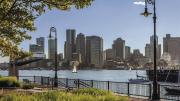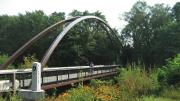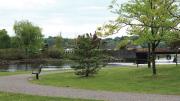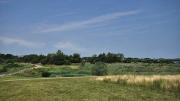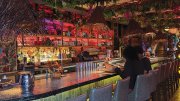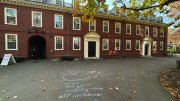Compared to that vast metropolitan zone to the southwest where concrete environs pack in the summer heat like a giant beehive oven, Greater Boston is an airy, pleasant place to spend the summer. The student population ebbs and easy access to open space, parks, esplanades, and water—the Charles and Neponset Rivers, Boston Harbor, or multiple public sprinklers and fountains—allows those out and about to find a spot of shade and a breeze, often carrying a salty edge.
What follows is a selection of picnic spots accessible by foot, bike, and subway for anyone adventurously inclined to embrace summering in the city.
In South Boston, the 22-acre Castle Island/Pleasure Bay park lands offer pedestrian and bike paths, a sandy beach, and the pentagonal Fort Independence. The last, a granite behemoth built between 1834 and 1851 (although the site has included some form of defense structure since 1634), is a National Historic Landmark open for weekend tours. The surrounding grassy slopes offer clear views of a few fishing piers and of the Boston Harbor islands, some prime picnic spots themselves. (For details, visit www.mass.gov/eea/agencies/dcr/massparks/region-boston/castle-island-pleasure-bay-m-street-and-carson-beach.html.)
Castle Island is one in a series of trails and destinations (not contiguous, and still very much a “work in progress”) called the Boston HarborWalk. Worth exploring in its entirety, the park district runs through Boston’s waterfront lands, historic sites, and neighborhoods, from East Boston and Charlestown to South Boston, Dorchester, and along the Neponset River Greenway (www.bostonnatural.org/gwynep.htm).
The HarborWalk’s 2.4-mile Lower Neponset River Trail (www.mass.gov/eea/agencies/dcr/massparks/region-boston/lower-neponset-river-trail.html) offers numerous places for picnics, soccer and Frisbee games, or kite-flying. A mixed-use route for bikes and walkers, it extends from the Port Norfolk section of Dorchester, through marshlands, into the town of Milton. Spend some time in the 65-acre Pope John Paul II Reservation. Thanks to continuing restoration efforts, the site, which once held a dump and drive-in movie theater, is now slowly growing back into a semi-native habitat, and birds are rediscovering its flora. (Take the MBTA Red Line to Fields Corner and bike three miles from there, or board buses 201/202.)
At a different end of the city, the bustling community of East Boston is known for an array of Latin American restaurants, bakeries, and cafés (see “Food Fiesta,” July-August, 2014). It’s also home to several green corridors along the terrific and underutilized East Boston Greenway, a bike trail, and the stunning Piers Park. The park, owned and maintained by Massport (which also operates the adjacent Logan Airport), offers a pedestrian promenade with two pavilions, a community sailing center, an outdoor gym, and a playground with a fanciful sprinkler that even adults will want to skip through on a scorcher. Don’t miss the wondrous views of the Boston skyline—especially just before dusk. (Take the Blue Line to Maverick Station and walk, or bike, the half-mile to the park.) Also appealing is the nearby Boston Harbor Shipyard and Marina, a funky commercial and artistic enclave: do try the Australian-style “pie floater” at KO Catering and Pies (www.kocateringandpies.com).
Thanks to farsighted environmental activism, the Charles River is now a joy to explore, particularly during the summer. Take out any manner of boat, or walk or bike along the enveloping green (and quite peaceful) “Upper Charles River” paths that hug the embankments in Watertown, Newton, and Waltham. Dotted throughout are wooden benches and viewing decks; consider lingering to eat near the beautiful Blue Heron Bridge, by Albemarle Road in Newton (www.mass.gov/eea/agencies/dcr/massparks/region-boston/upper-charles-river-reservation.html).
